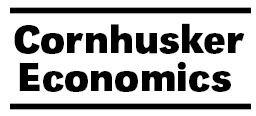Agricultural Economics Department
Date of this Version
11-30-2022
Document Type
Article
Citation
Cornhusker Economics (November 30, 2022)
Agricultural Economics, University of Nebraska-Lincoln
Abstract
Ecosystem services from farmland conservation are public good benefits. The value of these benefits is primarily measured using methods that determine the willingness to pay (WTP) for those benefits. Prairie strips, a farmland conservation practice, provide ecosystem services such as improved water quality, soil health, and biodiversity (Schulte et al., 2017). The state of Iowa is a major corn producer and contributes significant amounts of nitrogen and phosphorous to the Gulf of Mexico (Alexander et al., 2008). The development of conventional agricultural systems has also resulted in a significant loss of biodiversity, including a dominant land cover of tallgrass prairie. Currently, Iowa's prairie communities cover less than 0.1 percent of the area that existed before the Euro-American settlement (Liebman et al., 2013). Prairie strips are strips of native perennial grasses and forbs within row crop fields and are shown to improve soil, water, and biodiversity (Schulte et al., 2017). The Science-based Trials of Rowcrops Integrated with Prairie Strips (STRIPS) team in Iowa has been operating as a pilot program for more than fifteen years, during which it has helped match funding to landowners to incorporate prairie strips and analyzed the impacts on environmental indicators.
Our analysis suggests that some investment in prairie strips via the United States Department of Agriculture Conservation Reserve Program or other conservation programs in Iowa is justified based upon the value of resulting public and private benefits.
Included in
Agricultural Economics Commons, Agricultural Science Commons, Botany Commons, Environmental Health and Protection Commons, Environmental Policy Commons, Natural Resources and Conservation Commons, Natural Resources Management and Policy Commons, Sustainability Commons

